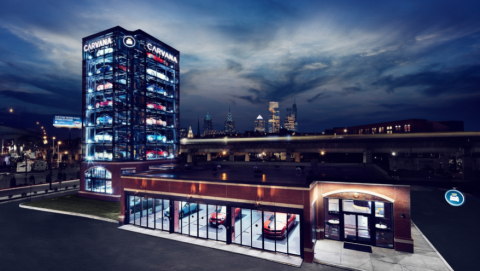COMMENTARY: Carvana glistened on this sunny day in NC

Carvana vending machine. Photo courtesy of the company.
This past Saturday included beautiful weather here in central North Carolina — bright sunshine, a slight breeze and clouds like they had been painted for a baby’s room. It was the kind of Saturday dealership general managers often hope lead to active showrooms, busy finance directors and vehicles rolling over the curb at a nice clip.
As I departed home a little before lunchtime, oncoming traffic continued to illustrate how Saturdays illuminated by beautiful weather can be wonderful for the car business. However, an individual in my neighborhood who took delivery never went to a dealership. You see, the truck I passed was a Carvana flatbed carrying a late-model Honda Civic in glistening silver.
That particular Carvana turn arrived following a year in which the company reported that it retailed 94,108 used vehicles in 2018, representing an increase of 113 percent year-over-year.
Carvana also shared last Wednesday that 2018 revenue came in at $1.96 billion, marking an increase of 128 percent year-over-year. The company watched its total gross profit spike 189 percent year-over-year to $196.7 million as gross per unit rose $594 to $2,133.
While I didn’t connect with the individual who now is driving that Honda Civic, about a year ago I struck up a conversation with another neighbor who made a vehicle purchase via Carvana. (Coincidently, it also was a Civic.) Being an observer of wholesale, retail and finance activities here for Cherokee Media Group, I asked the individual how the experience was securing a vehicle through Carvana.
That individual has well-paying employment in the technology field but has a thin credit file, so obtaining financing was difficult. But the individual noted the process with Carvana was simple and the family of four gained reliable transportation.
Later on this beautiful Saturday, I noticed other vehicles with indications of recent delivery. They had dealership decals from both franchised and independent stores. I also noticed a few other vehicles with those blue Carvana license plate brackets. (They mix in nicely in this area with individuals who have a similar item on their vehicles in support of the University of North Carolina that has a similar color scheme.)
In its 29-page letter to shareholders, Carvana chairman and chief executive officer Ernie Garcia and chief financial officer Mark Jenkins shared more company superlatives.
Carvana now operates in 72 markets, adding 41 more locales last year. If customers want an even more unique experience instead of just having a flatbed roll up with their purchase, Carvana now has 15 of those vending machines described eloquently here by my colleague Joe Overby.
Garcia and Jenkins pointed out that Carvana’s gross per unit is now more than $1,000 higher now than it was two years ago.
And we also shared through our Cherokee Media Group reports, Carvana has a significant relationship with Ally Financial and now its vehicles also are included within the Bank of America shopping and financing platform.
“Four weeks ago, we celebrated the sixth anniversary of launching a whole new way to buy a car to customers in Atlanta,” Garcia and Jenkins wrote in the shareholder letter summary.
“In that time, we have accomplished a lot,” they continued. “We have progressed from an idea germinating in the minds of a few passionate people, to a product customers love, to an incredible business with even more incredible prospects. In that first year, we sold fewer than 250 cars including a blockbuster month in December where we chalked up 42 deliveries. Since then, we have grown at triple digit rates every single quarter.
“That growth is pretty profound and it comes from two powerful forces: our customers’ love for our product, and our people’s love for building and delivering it. Our team is energized, focused, and executing at the highest level in our history. If we do our jobs from here, those same two forces will drive us to our goal of selling 2 million units per year,” they went on to say.
No doubt, Carvana is going to need much more than sunny Saturdays to deliver 2 million units annually. Even CarMax — which operates 186 locations nationwide — retailed 721,512 units during its 2018 fiscal year, according to the company. That figure is up from 526,929 vehicles during its 2014 fiscal year.
However, Carvana seems well on its way toward achieving its ambitious objective, especially with how people like to make purchases nowadays along with scale and financial resources at its disposal. The company set ambitious goals for 2019, looking to be retailing in 145 markets and turning 160,000 vehicles by the end of this year.
“Our ability to execute at even greater scale continues to give us confidence in our path to selling 2 million cars per year,” Garcia reiterated in a company news release.
Should Carvana hit that target, it indeed would be a sunny day for the company.
Nick Zulovich is part of the team at Cherokee Media Group and senior editor of Auto Fin Journal, SubPrime Auto Finance News and BHPH Report. He can be reached at nzulovich@cherokeemediagroup.com.

 View The Latest Edition
View The Latest Edition

